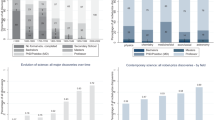Abstract
This paper contributes to the debate on high-skilled migration byexamining whether the foreign-born and foreign-educated are disproportionatelyrepresented among individuals making exceptional contributions to science and engineering (S & E) in the U.S. Six indicators of scientific achievement areused: individuals elected to the National Academy of Sciences and/or National Academy of Engineering, authors of citation classics, authors of hot papers, the 250 most-cited authors, authors of highly cited patents, and scientistswho have played a key role in launching biotechnology firms. We do not claim that this list is exhaustive, merely illustrative.
Using a variety of sources, we are able to determine the birth andeducational origin of 89.3% of the study group of over 4,500 scientists and engineers. For each indicator of scientific achievement, we test to see if the observed frequency by birth (or educational) origin is significantly differentfrom the frequency one would expect given the composition of the scientific labor force in the U.S. We find that although there is some variation by discipline, individuals making exceptional contributions to S & E in the U.S. aredisproportionately drawn from the foreign born. Only in the instance of hot papers in the life sciences were we unable to reject the null hypothesis that the proportion is the same as that in the underlying population. The most frequent country of origin in the life sciences is Great Britain followed by Germany. In the physical sciences the reverse is true. We also find that individuals making exceptional contributions are, in many instances, disproportionately foreign educated, both at the undergraduate and at the graduate level.
We conclude that immigrants have been a source of strength and vitalityfor U.S. science and, on balance, the U.S. appears to have benefited from the educational investments made by other countries. We do not investigate, however, whether U.S. scientists and engineers have borne part of thecost of the inflow of foreign talent by being displaced from jobs and/or earning lower wages. Nor do we investigate the cost to the countries of origin.
Similar content being viewed by others
REFERENCES
Albert, M. B., Avery, D., Narin, F. & McAllister, P. (1991), Direct validation of citation counts as indicators of industrially important patents, Research Policy 20: 251-259.
Audretsch, David & Stephan, Paula E. (1996), Company-scientist locational links: The case of biotechnology, American Economic Review 86: 641–652.
Bhagwati, J. & Rao, Milind (1996), Wall Street Journal 31 August.
Borjas, George J. (1994), The economics of immigration, Journal of Economic Literature 32: 1667–1717.
Borjas, George J. (1999), Heaven's Door, Princeton University Press, Princeton, NJ.
Britton, J.P. (1964), The Productivity of Scientists: A Prelude to Manpower Studies (unpublished paper), Department of History of Science and Medicine, Yale University, New Haven.
The Economist (1999), Proteins and particles, The Economist 84–85.
Finn, Michael G. (1995), Stay Rates of Foreign Doctorate Recipients from U.S. Universities, Oak Ridge Institute for Science and Education, Oak Ridge, TN.
Finn, Robert (1995), Scientist'; heated debate on immigration mirrors issues argued throughout U.S., The Scientist 9(23): 1, 8–9.
Garfield, Eugene (1979), Citation Indexing — Its Theory and Application in Sciences, Technology and Humanities, Wiley, New York.
Glanz, James (1996), Proposals that would limit visas strike fear at universities, Science 272: 190–191.
Levin, Sharon G. & Stephan, Paula E. (1999), Are the foreign born a source of strength for U.S. science?, Science 285: 1213–1214.
Levin, Sharon G., Stephan, Paula E. & Winkler, Anne E. (2000), 'Imported brains in science and engineering: Employment consequences for U.S.-citizens, Paper prepared for presentation at the Conference on Migration and Development, Office of Population Research, Princeton University, May 4–6, 2000.
Lotka, A.J. (1926), The frequency distribution of scientific productivity, Journal of the Washington Academy of Sciences 16: 317–323.
North, David (1995), Soothing the Establishment, University Press of America, Latham, MD.
Phillips, Michael M. (1996), Math Ph.D.s add to anti-foreigner wave, Wall Street Journal September 4, Section A, p.2.
Price, Derek J. de Solla (1986), Little Science, Big Science...And Beyond, Columbia University Press, New York.
Rao, Milind (1995), Foreign students and graduate economic education in the United States, Journal of Economic Education26: 274–281.
Ries, Paula & Thurgood, & D.H. (1991), Summary Report 1991: Doctorate Recipients from United States Universities, National Academy Press, Washington, DC.
Siegel, S. (1956), Nonparametric Statistics for the Behavioral Sciences, McGraw Hill, New York.
Stephan, Paula & Levin, Sharon G. (1991), Inequality in scientific performance: Adjustment for attribution and journal impact, Social Studies of Science 21: 351–368.
Stephan, Paula & Levin, Sharon G. (1995), Final Report, Sloan Foundation Grant #93-5-3.
Svorny, S. (1991), Consumer gains from physician immigration to the U.S.: 1966–1971, Applied Economics23(2): 331–337.
Teitelbaum, Michael (1996), Too many engineers, too few jobs, New York Times March 19, Section A, p. 23.
Trajtenberg, M. (1990), A penny for your quotes: Patent citations and the value of innovations, Rand Journal of Economics21(1) 172–187.
Author information
Authors and Affiliations
Rights and permissions
About this article
Cite this article
Stephan, P.E., Levin, S.G. Exceptional contributions to US science by the foreign-born and foreign-educated. Population Research and Policy Review 20, 59–79 (2001). https://doi.org/10.1023/A:1010682017950
Issue Date:
DOI: https://doi.org/10.1023/A:1010682017950




